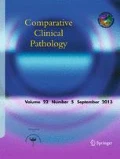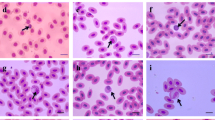Abstract
Dromedary camel is a seasonal breeder, with the maximum breeding activity during winter and spring and minimum activity occurring in summer and autumn in female camels of southwest Iran. This study was performed to investigate hematological and serum biochemical changes during breeding and non-breeding seasons in female camels, raised in Khouzestan Province. Blood samples were collected from 32 apparently healthy female dromedary camels during December to March as breeding period and from June to October as non-breeding period. Complete blood counts and serum biochemical parameters were analyzed. The results revealed a significant rise in erythrocyte markers including RBC, Hb, HCT, and MCHC in peak breeding season. Serum creatinine concentration in the breeding season was significantly higher than the non-breeding one. Cholesterol and triglyceride levels were both significantly increased in camels sampled during their maximum breeding time. There was also a significant elevation in protein concentration in the mentioned group (P < 0.05). Phosphorus and magnesium levels, in contrast to calcium, were higher in the breeding period (P < 0.05). The activity of serum enzymes comprising LDH, GGT, and ALT was significantly increased in the breeding season (P < 0.05). In spite of that, total bilirubin concentration declined in the same period. It can be concluded that reproductive status can make a considerable alteration in hematologic and biochemical profile in female dromedary camel which must be considered when interpreting laboratory data obtained from this species.
Similar content being viewed by others
References
Abo-El maaty AM, El-Shahat KH (2012) Hormonal and biochemical serum assay in relation to the estrous cycle and follicular growth in Arabian mare. Asian Pac J Reprod 1(2):105–110. https://doi.org/10.1016/S2305-0500(13)60059-7
Ahmadi-Hamedani M, Ghazvinian K, Darvishi MM (2014) Hematological and serum biochemical aspects associated with a camel (Camelus dromedarius) naturally infected by Trypanosoma evansi with severe parasitemia in Semnan, Iran. Asian Pac J Trop Biomed 4(9):743–745
Al Eknah MM (2000) Reproduction in old world camels. Anim Reprod Sci 60:583–592
Ali A, Tharwat M, Al-Sobayil FA (2010) Hormonal, biochemical, and hematological profiles in female camels (Camelus dromedarius) affected with reproductive disorders. Anim Reprod Sci 118(2):372–376
Alshamisi NS, Ksiksi TS, Ashraf SS (2013) Hematology analysis as a potential tool to predict bone fracture in Arabian racing camels (Camelus dromedaries). J Anim Plant Sci 23(3):763–770
Babeker EA, Elmansoury YHA, Suleem AE (2013) The influence of seasons on blood constituents of dromedary camel (Camelus dromedaries). Online J Anim Feed Res 3(1):1–8
Elias E, Bedrak E, Yagil R (1984) Estradiol concentration in the serum of the one humped camel Camelus dromedarius during the various reproductive stages. General Comp Endocrinol 56(2):258–264. https://doi.org/10.1016/0016-6480(84)90039-X
Farooq U, Samad HA, Khurshid A, Sajjad S (2011) Normal reference hematological values of one-humped camels (Camelus dromedarius) kept in Cholistan desert. J Anim Plant Sci 21(2):150–160
Gandotra VK, Choudhary KR, Sharma RD (1993) Serum biochemical constituents in normal and repeat breeder rathi cows. Indian J Anim Sci 52:944–946
Ghoneim IM, Waheed MM, Fouda TA, Al-Eknah MM, Al-Mugalli AM, El-Deeb WM, El Jalii IM (2014) Some biochemical and haematological aspects associated with pyometra and endometritis in female camels (Camelus dromedarius). J Camel Prac Res 21(1):99–102. https://doi.org/10.5958/2277-8934.2014.00019.8
Grimbert S, Fisch C, Deschamps D, Berson A, Fromenty B, Feldmann G, Pessayre D (1995) Effects of female sex hormones on mitochondria: possible role in acute fatty liver of pregnancy. Am J Phys 268:107–115
Hekmatimoghaddam S, Sazmand A, Rasooli A, Hamidinejat H, Jafari H (2012) Laboratory tests in dromedary camels naturally infected with piroplasms in Iran: study and review of literature. J Camel Prac Res 19(2):217–221
Ix JH, Chonchol M, Laughlin GA, Shlipak MG, Whooley MA (2011) Relation of sex and estrogen therapy to serum fibroblast growth factor 23, serum phosphorus, and urine phosphorus: the Heart and Soul Study. Am J Kidney Dis 58(5):737–745. https://doi.org/10.1053/j.ajkd.2011.06.011
Janele D, Lang T, Capellino S, Cutolo M, Da Silva JA, Straub RH (2006) Effects of testosterone, 17beta-estradiol, and downstream estrogens on cytokine secretion from human leukocytes in the presence and absence of cortisol. Ann N Y Acad Sci 1069(1):168–182. https://doi.org/10.1196/annals.1351.015
Knopp RH, Walden CE, Wahl PW, Hoover JJ (1982) Effects of oral contraceptives on lipoprotein triglyceride and cholesterol: relationships to estrogen and progestin potency. Am J Obstet Gynecol 142(6):725–731. https://doi.org/10.1016/S0002-9378(16)32478-4
Lussier-Cacan S, Bolte E, Bidallier M, Huang YS, Davignon J (1977) Cyclic fluctuations of plasma cholesterol in the female miniature swine and its relationship to progesterone secretion. Exp Biol Med 154(3):471–474. https://doi.org/10.3181/00379727-154-39696a
Merkt H, Rath D, Musa B, El-Naggar MA (1990) Reproduction in camels, a review. Food and Agriculture Organization of the United Nations (FAO)
Meyer DJ, Harvey JW (2004) Veterinary laboratory medicine: interpretation & diagnosis, 3rd edn. Saunders, London
Ministry of Agriculture-Jahad (2015) Iran Agriculture statistics. Tehran. Iran. Accessed 2 June 2017
Musa BE, Abu Sineina ME (1978) The oestrous cycle of the camel (Camelus dromedarius). Vet Rec 103(25):556–557. https://doi.org/10.1136/vr.103.25.556
Nakada D, Oguro H, Levi BP, Ryan N, Kitano A, Saitoh Y, Takeichi M, Wendt GR, Morrison SJ (2014) Oestrogen increases haematopoietic stem-cell self-renewal in females and during pregnancy. Nature 505(7484):555–558. https://doi.org/10.1038/nature12932
Pelleymounter MA, Baker MB, McCaleb M (1999) Does estradiol mediate leptin’s effects on adiposity and body weight? Am J Physiol Endocrinol Metab 276(5):955–963
Quajd S, Kamel B (2009) Physiological particularities of dromedary (Camelus dromedarius) and experimental implications. Scand J Lab Anim Sci 36:19–29
Salehi M, Mirhadi A, Ghafouri-Kesbi F, Asadi Fozi M, Babak A (2013) An evaluation of live weight, carcass and hide characteristics in dromedary vs. Bactrian× dromedary crossbred camels. J Agri. Sci Technol 15(5):1121–1131
Seelig MS (1993) Interrelationship of magnesium and estrogen in cardiovascular and bone disorders, eclampsia, migraine and premenstrual syndrome. J Am Coll Nutr 12(4):442–458. https://doi.org/10.1080/07315724.1993.10718335
Swelum AA, Ismael AB, Khalaf AF, Abouheif MA (2014) Clinical and laboratory findings associated with naturally occurring babesiosis in dromedary camels. Bull Vet Inst Pulawy 58(2):229–233
Tharwat M (2015) Haematology, biochemistry and blood gas analysis in healthy female dromedary camels, their calves and umbilical cord blood at spontaneous parturition. J Camel Prac Res 22(2):239–245. https://doi.org/10.5958/2277-8934.2015.00039.9
Tharwat M, Ali A, Al-Sobayil F, Selim L, Abbas H (2015) Haematobiochemical profile in female camels (Camelus dromedarius) during the periparturient period. J Camel Prac Res 22(1):101–106. https://doi.org/10.5958/2277-8934.2015.00016.8
Tibary A, Anouassi A (1996) Ultrasonographic changes of the reproductive tract in the female camel during the follicular cycle and pregnancy. J Camel Prac Res 3:71–90
Tornquist AJ (2010) Hematology of camelids. In: Schalm’s veterinary hematology. (Weiss, D. J., K. J. Wardrop, Eds.), Wiley. pp. 910–917
Umaru MA, Bello A (2013) Reproduction in the one humped camel (Camelus dromedarius) in semi-arid Nigeria. Sci J Biol Sci 2(1):1–7
Yaqub LS, Kawu MU, Ayo JO, Ambali SF, Habibu B (2013) Effect of oestrous cycle on serum electrolytes and liver enzymes in Red Sokoto goats. Afr J Biochem Res 7(9):174–178
Yin M, Ikejima K, Wheeler MD, Bradford BU, Seabra V, Forman DT, Sato N, Thurman RG (2000) Estrogen is involved in early alcohol-induced liver injury in a rat enteral feeding model. Hepatol 31(1):117–123. https://doi.org/10.1002/hep.510310119
Acknowledgments
The authors would like to acknowledge all veterinarians and technicians in the Faculty of Veterinary Medicine, Shahid Chamran University of Ahvaz who helped in sample collection.
Author information
Authors and Affiliations
Corresponding author
Ethics declarations
Conflict of interest
The authors declare that they have no conflicts of interest.
Ethical approval
All applicable national, international, and/or institutional guidelines for the care and use of animals were followed.
Rights and permissions
About this article
Cite this article
Jalali, S.M., Hasani, Y.N., Darabifard, A. et al. A study of hematologic and biochemical profile in female dromedary camels during the breeding and non-breeding seasons. Comp Clin Pathol 27, 655–659 (2018). https://doi.org/10.1007/s00580-018-2645-1
Received:
Accepted:
Published:
Issue Date:
DOI: https://doi.org/10.1007/s00580-018-2645-1




